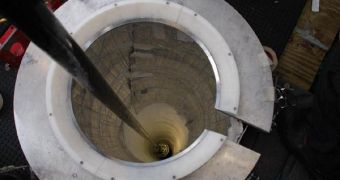Dark matter is supposed to be all around us, nevertheless we have failed so far to make a direct observation of a dark matter cloud. The giant neutrino detector located in Antarctica, IceCube, will most likely receive an upgrade in order to produce direct evidence that dark matter can be found in the center of the Milky Way's galactic nucleus, or even in the core of the Sun.
Neutrino, the first particle ever to be proposed as a dark matter constituent, represents an elementary particle that is mostly produced during energetic processes, such as that of nuclear fusion inside stars. The Earth is constantly bombarded with large quantities of neutrinos coming from the Sun's core. In fact, if these particles were visible, they would appear as the worst snow storm ever imagined. They present weak interactions with normal matter, which makes it a perfect candidate for dark matter.
More than a hundred million neutrinos pass through the fingertip of a human hand every second! Similar particles are produced through supernova explosions as well. The first evidence of such processes was observed in a supernova that exploded in the close proximity of the Large Magellanic Cloud, called 1987A.
The detection process involves observing the effects produced by the passing of neutrino particles through a mass of matter. When neutrinos interact with ice, they determine the emission of a muon particle which is captured by the detector. The only problem is that cosmic rays acting on the Earth's atmosphere produce a large amount of muon particles, thus, instead of pointing the detector towards neutrinos with downwards motion, IceCube is used to observe neutrinos that travel through the whole mass of the planet, in order to eliminate the problems created by the muons produced in the atmosphere.
Although neutrinos can be obtained through the decay of normal matter, it is generally believed that they can be also produced during annihilation processes of dark matter inside the core of the stars and the center of the Milky Way. Studying the core of the Sun with IceCube is relatively easy, however the core of the Milky Way is pointing in exactly the opposite direction of the detector.
In order to solve this little problem, physicists argue that the IceCube would require an additional six sets of strings equipped with 40 new detectors each. The problems related to the atmospheric muons could be resolved just by comparing the signals of the original detector and of the upgrade, in order to filter the additional amount of particles.

 14 DAY TRIAL //
14 DAY TRIAL //